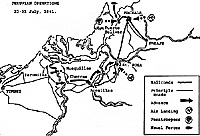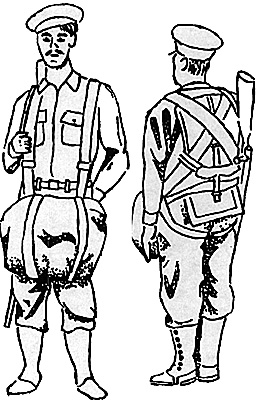Other Installments
 At the time the paratroopers dropped on Puerto Bolivar, the Air Force detachment assigned to link up with them was three kilometres from the town. Marching along a muddy road in two platoons separated by a distance of 100 meters, the detachment hurried forward when they heard firing coming from the direction of the town (Arana 1969, 250-251).
At the time the paratroopers dropped on Puerto Bolivar, the Air Force detachment assigned to link up with them was three kilometres from the town. Marching along a muddy road in two platoons separated by a distance of 100 meters, the detachment hurried forward when they heard firing coming from the direction of the town (Arana 1969, 250-251).
Lt. Col. Megee's account demonstrates, however, the capture of the town presented the paratroopers with little difficulty. Peruvian Naval forces took possession of the port, though it is not clear whether this occured simultaneous with the airborne assault, or only in its aftermath (Megee 1942, 63; Arana 1969, 227, 254). Incidentally, the three boxcars filled with the munitions so desperately needed by the Ecuadorian troops along the Zarumilla that the paratroopers captured were stranded at Puerto Bolivar as a result of sabotage to Ecuadorian locomotives by the Peruvian 'Fifth Column' (Zook 1964, 183).
Throughout the month of July negotiations had been in progress to bring an end to the conflict. An truce was reached no less than fifteen minutes after the paratroopers had descended upon Puerto Bolivar (not twenty-four hours later, as stated by Megee) (Megee 1942, 63; Zook 1964, 183-184; Wood 1978, 109; English 1984, 375; English 1991, 4) . The skill and precision with which the successive airborne attacks were carried out against Santa Rosa, Machala, and Puerto Bolivar are a testament to the level of professionalism attained by the Peruvian Armed Forces at the time of the war. Some Peruvian textbooks even make the dubious claim that President Manuel Prado was congratulated on his use of paratroopers by no less than Adolf Hitler (Wood 1978, 96)
Building on their successful record, Peru formed an Airborne Brigade later on in the 1940s and, sometime after 1945, the Brigade was expanded to the 'Division de Comandos'. Stationed at Callao, the Division consisted of one Airborne Battalion and two Commando Battalions (English 1984, 375-376) .
The next operational use of airborne forces in the Americas, however, would be by the Cuban 2506 Brigade at the Bay of Pigs in 1961, followed by the U.S. invasions of Grenada ('Urgent Fury') in 1983, and Panama ('Just Cause') in 1989 (ironically the United States' first airborne unit, the 501st Parachute Infantry Battalion, was transferred to Panama for further training in July, 1941) (Gregory 1979, 68) . Nonetheless, no other airborne forces in the Western Hemisphere, including those of the United States, can claim the title of the Peruvians of being the first in the field of battle.
PERUVIAN 'PARACAIDISTAS' UNIFORM, 1941.
The accompanying drawings are based on three B/W photographs appearing in Humberto Araujo Arana's Antecedentes y choques fronterizos, ocupación y desocupacion Peruana de territorio Ecuatoriano en 1941-1942 (Arana 1969, 357) . Unfortunately, these photos are far from clear, so that the details of the uniform and parachute harness are open to question. Judging by the other photographs in Snr. Arana's book, the uniform appears to conform to standard Air Force dress, consisting of khaki coloured cap, shirt, and trousers, with white harness straps and leggings, and dark coloured belt and shoes (presumably brown or black) .
This is in contrast with the Army's field grey uniforms (Norman 1993, 31; Bunkley 1993, 55; Hooker 1993, 90, 93) . The paratroopers appear to be armed with the standard Peruvian firearm of the period, the 7.65mm Mauser Model 1909 (English 1984, 373, 376) It is not entirely clear that the dress depicted in these photos corresponds to that used during a jump, for which the cap and the rifle held only by its shoulder strap would appear to be inappropriate.
SOURCES:
Arana, Humberto Araujo (1969) Antecedentes y choques fronterizos, ocupación y
desocupacion Peruana de territorio Ecuatoriano en 1941-1942, Lima: Primera
Edicion, 1969.
Bunkley, J. W. (1942) "Extracts from "Military and Naval Recognition Book", El
Dorado, Vol.6, No.2. August-October 1993, pp.54-55.
English, Adrian J. (1984) Armed Forces of Latin America, London, Jane's 1984.
Gregory, Barry and Batchelor, John (1979) Airborne Warfare 1918-1945, New York,
Exeter Books, 1979.
Hooker, Terry D. (1993) "Peruvian Army 1940-43", El Dorado, Vol.6, No.2. August-
October 1993, pp.90, 93.
Lundari, Giuseppe (1989) I Paracadutisti Italiani 1937-45, Serie de Bello No.9, Milan,
Editrice Militare Italiana, 1989.
Megee, Vernon E. (1942) "An Aerial Blitzkrieg in Miniature", The Marine Corps
Gazette, Vol.26, No.1. March 1942, pp.7-8, 63.
Norman, C. A. (1993) "Peru, 1940's", El Dorado, Vol.6. No.1. May-July, 1993, pp.31,
33.
Wood, Bryce (1978) Aggression and History: The Case of Ecuador and Peru, Ann Arbor,
Michigan: University Microfilms International - Published for the Institute of
Latin American Studies, Columbia University, 1978.
Zook, David H. (1964) Zarumilla - Maranon: The Ecuador - Peru Dispute, New York,
Bookman Associates, 1964.
Zook, David H. and Higham, Robin (1966) A Short History of Warfare, New York, Twayne, 1966.

Back to Table of Contents -- El Dorado Vol VIII No. 2
Back to El Dorado List of Issues
Back to MagWeb Master Magazine List
© Copyright 1998 by The South and Central Military Historians Society
This article appears in MagWeb (Magazine Web) on the Internet World Wide Web.
Other military history articles and gaming articles are available at http://www.magweb.com